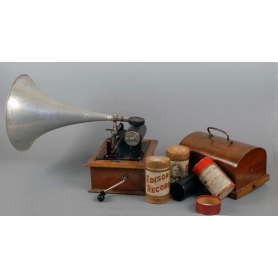No products
Prices are tax excluded
Detailed privacy of the user registry: Here
Legal notice and detailed cookies policy. By continuing to use the site, you accept our use of cookies: Find out more.
106.45
New
Phonograph J. GIRARD & CIE. France, the end of the NINETEENTH century.
With two cylinders Edison.
In operation.
Measures: 21,5 x 26,5 x 17 cm; 32 x 24 cm (tube).
Warning: Last items in stock!
Availability date:

PHONOGRAPH the LATE NINETEENTH century
Phonograph J. GIRARD & CIE. France, the end of the NINETEENTH century.
With two cylinders Edison.
In operation.
Measures: 21,5 x 26,5 x 17 cm; 32 x 24 cm (tube).
Recipient :
* Required fields
or Cancel
The phonograph was the most common device for playing recorded sounds during the seventies of the NINETEENTH century, being in the following decade, replaced by the gramophone, which used flat disks instead of cylinders. The phonograph had, however, a great advantage compared to the new system, because with it the users could record their own cylinders, with music or voices. Thomas Edison announced the invention of his first phonograph in 1877, patentándolo the following year. Its precedent was the fonoautógrafo, patented by Scott de Martinville in 1857, which could transmit a sound vibration, a visible means, but I didn't have a mode to be played back later. It was therefore considered a laboratory curiosity, used for acoustic study. The phonograph, as the fonoautógrafo, uses a system of recording mechanical analog in which the sound waves are transformed into mechanical vibrations by a transducer acousto-mechanical. These vibrations move a stylus ploughing a furrow spiral on a cylinder phonograph. To play the sound, just reverse the process. At the beginning we used cylinders of cardboard covered in tin, later of cardboard waxed and, finally, of solid wax. The cylinder of wax, the highest quality and durability, was marketed from 1889.
No customer reviews for the moment.